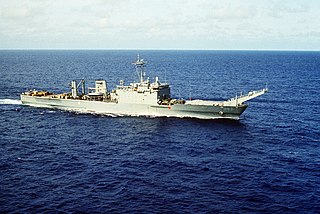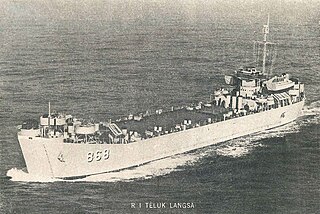
USS Frederick (LST-1184) was a Newport-class tank landing ship which replaced the traditional bow door-design tank landing ships (LSTs) of the United States Navy. The ship was named after the city of Frederick, Maryland and Frederick County, Maryland. The vessel entered service in 1970 with the United States Pacific Fleet and saw service during the Vietnam War, and the Persian Gulf War earning three battle stars. The ship was decommissioned in 2002 and put up for sale.

USS Saginaw (LST-1188) was the tenth of the Newport-class tank landing ships of the United States Navy which replaced the traditional bow door-design tank landing ships (LSTs). The second ship of that name, Saginaw was named after the river in Michigan. The LST was constructed by National Steel and Shipbuilding Company of San Diego, California, launched in 1970 and commissioned in 1971. During service with the United States Navy, the ship took part in US efforts in the Lebanese civil war and the Gulf War. Saginaw was decommissioned on 28 June 1994 and was transferred to the Royal Australian Navy on 28 August that year.
USS ''LST-84'' was one of the hundreds of Tank landing ships built during World War II to support amphibious military operations. Her role was to carry significant quantities of vehicles, cargo, and troops directly onto an unimproved shore. The ship was sponsored by Mrs. W. Raymond Brendel. The ship was constructed inland at Jeffersonville, Indiana, by the Jeffersonville Boat & Machine Co. as coastal ship yards were used to build larger naval vessels. The ship traversed the Ohio and Mississippi River to reach open water.

USS Tuscaloosa (LST-1187), the ninth of the Newport-class tank landing ships of the United States Navy which replaced the traditional bow door-design tank landing ships (LSTs). The vessel was constructed by the National Steel and Shipbuilding Company in San Diego, California and was launched in 1969 and commissioned in 1970 and the second ship of the United States Navy to be named after the city of Tuscaloosa, Alabama. The LST participated in the Vietnam War and was decommissioned in 1994. The ship was laid up until being sunk as a target ship during a sinking exercise in 2014.

USS Newport (LST-1179) was the third ship of the United States Navy (USN) to bear the name of the Rhode Island city. The first of her class of landing ship tanks (LST), she was capable of a sustained speed of 20 knots (37 km/h). Her ability to adjust her draft, accompanied by her unique bow-ramp design, helped bring a new degree of responsiveness to the amphibious fleet. The ship was launched in 1968 entered service with the USN in 1969. Assigned to the United States Atlantic Fleet for the entirety of her career, Newport made deployments to the Mediterranean and Caribbean Seas. The vessel was taken out of service in 1992 and laid up until 2001

USS Sumter (LST-1181) was the third of twenty Newport-class tank landing ships in service with the United States Navy, which replaced the traditional bow door-design tank landing ships (LSTs). Sumter was constructed by Philadelphia Naval Shipyard in Philadelphia, Pennsylvania and was launched in 1969. The ship entered service in 1970, was assigned to the Pacific coast of the United States and deployed to the western Pacific twice during the Vietnam War. In 1973, Sumter was reassigned to the Atlantic coast and took part in operations in along the Eastern Seaboard of the United States, the Mediterranean Sea and the Caribbean Sea. The LST was decommissioned in 1993.

USS Cayuga (LST-1186) was a Newport-class tank landing ship of the United States Navy which replaced the traditional bow door-design tank landing ships (LSTs). The vessel was constructed by the National Steel and Shipbuilding Company in San Diego, California and was launched in 1969 and commissioned in 1970. Cayuga took part in the Vietnam War and Gulf War in American service. Decommissioned in 1994, the LST was transferred to the Brazilian Navy the same year on loan and renamed NDCC Mattoso Maia. The ship was purchased by Brazil outright in 2001. Mattoso Maia is currently in service.

USS Peoria (LST-1183) was a Newport-class tank landing ship which replaced the traditional bow door-design tank landing ships (LSTs). The vessel took part in the Vietnam War and Gulf War. The ship was constructed by the National Steel and Shipbuilding Company in San Diego, California and was launched in 1968 and commissioned in 1970. Named for a city in Illinois, Peoria was assigned to the United States Pacific Fleet and home ported at San Diego. The tank landing ship alternated between military exercises along the United States west coast and deployments to the western Pacific. Peoria took part in the evacuations of Phnom Penh, Cambodia and Saigon, South Vietnam, both of which signaled the end of American involvement in the respective countries. The vessel was decommissioned 1994 and sunk as a target ship during a RIMPAC naval exercise in 2004.

USS Barbour County (LST-1195) was the seventeenth ship of the twenty Newport-class tank landing ships of the United States Navy (USN) which replaced the traditional bow door-design tank landing ships (LSTs). The vessel was named after two counties; one in Alabama, and the other in West Virginia. The LST was constructed by National Steel and Shipbuilding Company of San Diego, California. Barbour County was launched in 1971 and commissioned into the USN in 1972. Barbour County took part in the Vietnam War, including the evacuation of Saigon and the Gulf War. The LST also performed disaster relief in Bangladesh. The vessel was decommissioned in 1992 and laid up with plans to sell the ship. This did not happen and the vessel was struck from the Naval Vessel Register in 2001 and sunk as a target ship in 2004.

USS LST-519 was an LST-491-class tank landing ship built for the U.S. Navy in World War II. She was later renamed USS Calhoun County (LST-519) after counties in eleven states in the United States.

USS Morgan County (LST-1048) was an LST-542-class tank landing ship built for the United States Navy in World War II. Like most ships of her class, she was originally known only by her designation, USS LST-1048, and, like all remaining LSTs, was named on 1 July 1955, after eleven counties in the U.S.

USS San Bernardino (LST-1189) was the eleventh of twenty Newport-class tank landing ships of the United States Navy (USN) which replaced the traditional bow door-design tank landing ships (LSTs). The second USN ship to be named after the city in California, the ship was constructed by National Steel and Shipbuilding Company of San Diego, California. The LST was launched in 1970 and was commissioned in 1971. San Bernardino participated in the Vietnam War, earning one battle star and took part in operations in the Middle East. The ship was decommissioned 1995 and transferred to the Chilean Navy. In Chilean service, the vessel was renamed Valdivia (LST-93) for a battle during the Chilean War of Independence. The LST was recommissioned that year and during its service, took part in humanitarian efforts following earthquakes in Chile in 2010. In 2011 the Chilean Navy took Valdivia out of service due to repairs to the ship no longer being economical.

USS Racine (LST-1191) was the thirteenth of twenty Newport-class tank landing ships of the United States Navy (USN) which replaced the traditional bow door-design tank landing ships (LSTs). The second ship named after the city in Wisconsin, the ship was constructed by National Steel and Shipbuilding Company of San Diego, California. The LST was launched in 1970 and was commissioned in 1971. Racine was assigned to the United States west coast and deployed to the western Pacific Ocean during the Vietnam War. The ship was transferred to the Naval Reserve Force in 1981. The LST was decommissioned in 1993 and placed in reserve. Racine was struck from the Naval Vessel Register in 2008 and after an attempted sale to Peru failed, was discarded as a target ship during a sinking exercise in July 2018.

USS Fresno (LST-1182) was the fourth tank landing ship (LST) of the Newport class. Fresno was named for a county in California. The vessel was constructed by the National Steel and Shipbuilding Company in San Diego, California and launched in 1968. The ship entered service in 1969 and was assigned to the United States Pacific Fleet, taking part in training along the west coast and operational cruises to the western Pacific, taking part in the Vietnam War. Fresno was decommissioned in 1993 and laid up. The LST was nearly sold to Peru but remained in the U.S. inventory until 2014, when Fresno was sunk as a target ship in the Pacific Ocean during a training exercise off Guam.

USS Schenectady (LST-1185) was the fifth Newport-class tank landing ship which replaced the traditional bow door-design tank landing ships (LSTs). It was delivered to the US Navy on 1 May 1970 and commissioned on 13 June 1970. Schenectady operated in support of American forces in Vietnam and Operations Desert Shield and Desert Storm. It was decommissioned on 15 December 1993 and held in reserve until it was sunk as a target on 23 November 2004.

USS Spartanburg County (LST-1192) was the fourteenth of twenty Newport-class tank landing ships of the United States Navy (USN) which replaced the traditional bow door-design tank landing ships (LSTs). Named after a county in South Carolina, the ship was constructed by National Steel and Shipbuilding Company of San Diego, California. The LST was launched in 1970 and was commissioned in 1971. Assigned to the United States Atlantic Fleet, Spartanburg County deployed regularly to the Caribbean and Mediterranean Seas. In 1983 and 1985, the vessel was present in Lebanese waters. In 1990, the LST was deployed to the Persian Gulf in the Gulf War, returning to the United States in 1991. Spartanburg County was decommissioned and struck from the Naval Vessel Register in 1994.

USS Fairfax County (LST-1193) was the fifteenth of twenty Newport-class tank landing ships of the United States Navy (USN) which replaced the traditional bow door-design tank landing ships (LSTs). Named after a county in Virginia, the ship was constructed by National Steel and Shipbuilding Company of San Diego, California. The LST was launched in 1970 and was commissioned into the USN in 1971. Fairfax County was alternated deployments between the Caribbean Sea and the Mediterranean Sea. During the Gulf War, Fairfax County was deployed off the northern African coast as part of a deterrent force. The ship was decommissioned from the USN in 1994.

USS Bristol County (LST-1198) was the last of the twenty Newport-class tank landing ships of the United States Navy (USN) which replaced the traditional bow door-design tank landing ships (LSTs). The LST was constructed by National Steel and Shipbuilding Company of San Diego, California. Bristol County was launched in 1971 and commissioned into the USN in 1972. Bristol County was assigned to the United States Pacific Fleet and remained in service until 1994 when it was decommissioned. Sold to Morocco that year, the vessel was recommissioned into the Royal Moroccan Navy as Sidi Mohammed Ben Abdellah. The ship remains in service.
USS LST-766 was an LST-542-class Landing Ship, Tank in the United States Navy during World War II that took part in the amphibious landings during the war in the Far East.

USS Solano County (LST-1128) was a LST-542-class tank landing ship in the United States Navy during World War II. She was transferred to the Indonesian Navy as KRI Teluk Langsa.



















